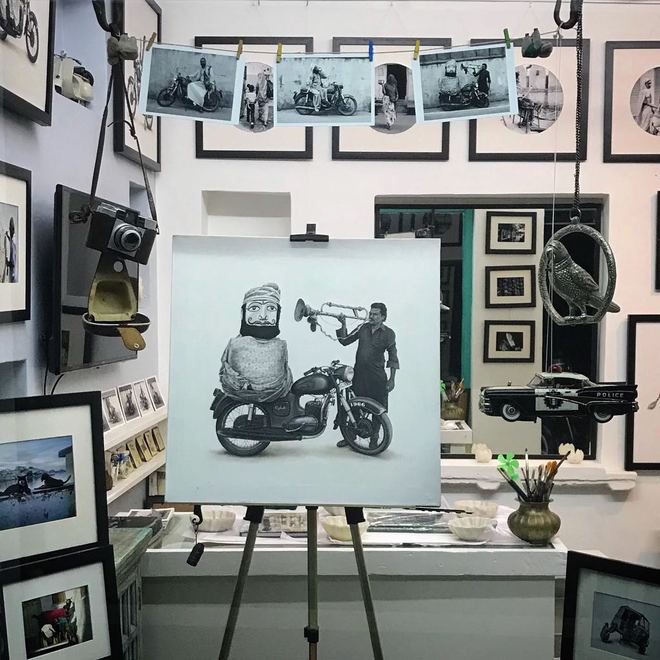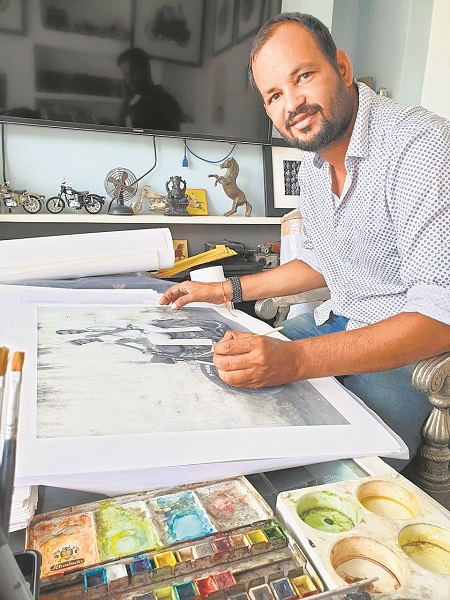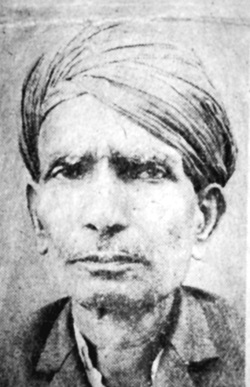
Neha Kirpal
As one walks down the narrow, bustling lanes of Chandpole in the heart of Udaipur, a small pastel blue coloured gallery catches the eye. The black and white photographs and artwork that its walls are covered with echo a scene of contemporary Rajasthan. Inside, Rajesh Soni is meticulously handpainting photographs.

old art of handpainting black and white photographs
The owner of Gallery One, Rajesh is primarily known for his abilities to handpaint black & white photographs and ink drawings of Udaipur’s unique heritage buildings. A third generation artist, he is continuing his family’s legacy of hand colouring vintage studio photographs. His grandfather, Prabhu Lal Soni, was a court photographer and hand colourist to the last king of Mewar, Maharana Bhopal Singh. Having learnt photography and painting in his childhood, Prabhu Lal would shoot almost all of the royal family’s events. Most of his photographs have been displayed at Udaipur’s City Palace Museum.
“Back then, in the early 1900s, my grandfather even created his own camera,” says a proud Rajesh. His father, Lalit Soni, went on to learn the skill from his father. He too did a lot of work for weddings of both the locals as well as the royal family. The skill has now been passed on to Rajesh, who says his attempt has been to contemporise his family’s art.
Rajesh uses high-quality water colours and thin paintbrushes to accentuate and darken the features of his subjects as well as brighten the greys of textures such as clothes, leaves or the sky in black and white photographs. He doesn’t use coloured photographs for reference; the selection of colours based on his imagination.

Prabhu Lal Soni
Given that it’s not easy to paint on the kind of fine art photography paper that is available these days, he has to use a soft hand in order to be extremely precise, intricate and minimalist in his approach. This alone ensures that the end result is a pastel effect in which the picture retains its vintage charm. Rajesh says that when compared with old photography paper, there is immense difference between the two. That also means a lot of factors need to be controlled.
“When yellow gets mixed with grey, it turns a kind of green. So, it’s very difficult to get a sense of the real colour on the pictures. I thus need to play with the images and control their printing too,” he explains. Further, he needs to manage the photo’s white balance and colour the photographs layer by layer. This often results in the use of a greater quantity of water than colour.
Another challenge is to not damage existing print on the paper. “I have to constantly maintain the speed of my brush and its movement. While painting, if I suddenly stop my hand at one point, the colour will go into the paper and get stuck like a spot which won’t be possible to remove,” he adds.
Over the years, Rajesh has also collaborated with international artists. In 1995, visiting Italian entrepreneur, M Claudio, bought a work of his. A few years later, Claudio invited Rajesh to visit him, giving him an opportunity to see and understand European art. Subsequently, Rajesh met French interior designer Matthew Paul, who commissioned him some work. He then met American artist Waswo X Waswo, with whom he collaborated for about 13 years. In the coming months, Rajesh is holding exhibitions of his latest work, Life on Wheels, in Qatar, France, Germany and Holland.
While he also conducts photography and art tours from time to time, he continues to do photo shoots at various spots in the city — streets, temples or lakes. “I love Udaipur. It’s a great place to capture interesting subjects, and I get a chance to meet people from all over the world,” he says.
Life in slow motion
 Rajesh Soni’s recent series is named Life on Wheels. He says two-wheelers are the most popular mode of transport among the locals with, sometimes, even a family of five seated on one! He thus came up with a concept where he would stop random people and ask them to pose on his vintage 1966 Rajdoot. In a city where owning a vehicle is considered a symbol of success, Rajesh wanted to capture their sense of achievement while being seated on a bike. Whether it’s photo of two generations of a family engaged in the same vocation or a puppet master playing a musical instrument, each photo tells a story.
Rajesh Soni’s recent series is named Life on Wheels. He says two-wheelers are the most popular mode of transport among the locals with, sometimes, even a family of five seated on one! He thus came up with a concept where he would stop random people and ask them to pose on his vintage 1966 Rajdoot. In a city where owning a vehicle is considered a symbol of success, Rajesh wanted to capture their sense of achievement while being seated on a bike. Whether it’s photo of two generations of a family engaged in the same vocation or a puppet master playing a musical instrument, each photo tells a story.
Join Whatsapp Channel of The Tribune for latest updates.



























